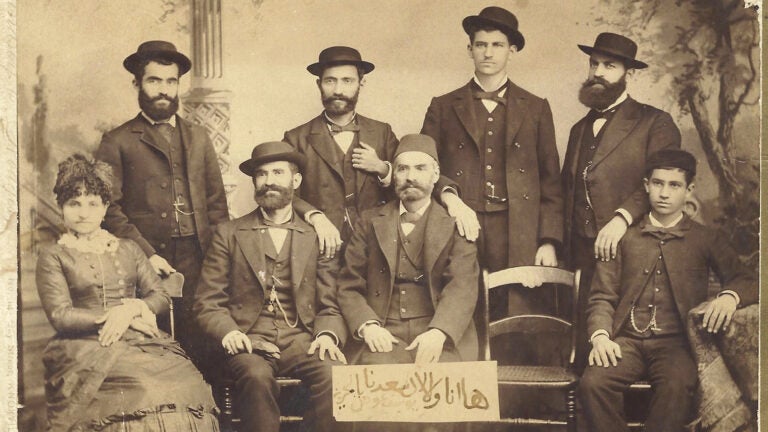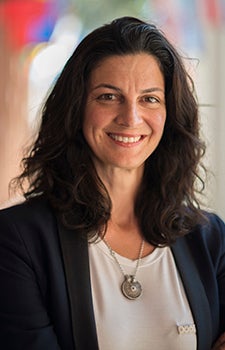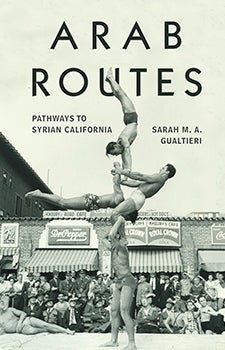
Arabs in California: Finding identity and belonging as an Arab American
In 2003, when Kathy Saade Kenny, the granddaughter of Palestinian immigrants, stumbled upon a mysterious cache of letters stored in an old See’s candy box tucked away in the back of a closet in her mother’s Los Angeles home, she was intrigued.
Inside the box were more than 130 letters written by her grandmother, Katrina Sa’ade. A successful businesswoman, Sa’ade had migrated to California from Palestine, via Mexico.
Suspecting the letters could provide a treasure trove of information about her family history, Kenny was excited to read them. However, as a third-generation immigrant, she didn’t possess the necessary key to unlock their secrets: The letters were written in Arabic.
Sarah Gualtieri describes this scene in her new book Arab Routes: Pathways to Syrian California (Stanford University Press, 2019), which explores how an Arab American community came into being in Southern California. In doing so, Gualtieri, associate professor of American studies and ethnicity, history and Middle East studies at USC Dornsife College of Letters, Arts and Sciences, re-inscribes Arabs into California history.
“Traditionally, California history hasn’t done a very good job of recognizing the deep roots of the Arab community here in the state,” Gualtieri says. “My book also pushes against this idea that circulates very widely in the media that Arabs are new immigrants, and that they are always somehow more Middle Eastern than they are American.”

Sarah Gualtieri (Photo: Peter Zhaoyu Zhou.)
Enlisting the help of a Palestinian historian and translator, Kenny embarked on a journey to unlock the secrets of her grandmother’s past. The translated letters revealed a complicated divorce case between her grandmother and her then-husband — a case that took her grandmother back and forth to Palestine.
“Kathy comes to understand her grandmother’s journey as a migrant, as a woman who came from Palestine to California through this unfolding mystery that’s revealed through her letters,” Gualtieri says. “Not only does Kathy discover an untold family drama, she starts to understand this whole dimension of her life in a new way. This helps her connect to her sense of Arabness and refine her identity as an Arab American.”
Gualtieri says the Arab American community often works to reconstruct their connection to their Middle Eastern roots. Many of those she interviewed during her research tended to mute their identity as Arab Americans — often, she says, because they came of age in the 1950s and ’60s, when, just as now, there was considerable hostility toward Arab countries.
The Latin American connection
The realization that people’s origins are frequently much more complex than they may appear on the surface is a key theme that runs through Gualtieri’s research. We tend to think of immigration as a unilinear journey, she argues, and don’t pay enough attention to the important role that’s played in shaping immigrants’ identities by the places where they live and spend time along the way.
Since the late 19th century, Syrian and Lebanese migration, in particular, to Southern California has been intimately connected to and through Latin America, and especially Mexico.
“This Latin American dimension of the Arab history in Southern California is not well known, and I wanted to tell that story,” Gualtieri said. “My book looks at what I call ‘other pathways’ to the U.S., and specifically to California, in particular at this southern route that so many Arabic-speaking migrants took to come to L.A.”
Gualtieri’s research goes beyond the Ellis Island stereotypes to uncover the stories of this Syrian American community, one both Arabized and Latinized, revealing important cross-border and multiethnic solidarities in Syrian California.
Sleepy Lagoon murder
Among them, she reveals the Syrian interests in the defense of the Mexican American teens charged in the 1942 Sleepy Lagoon murder.
Twenty-two alleged members of L.A.’s 38th Street Gang were accused of the murder of another Mexican American youth, José Díaz, who had been found unconscious and dying near a Commerce, California, reservoir. Nicknamed “Sleepy Lagoon,” the reservoir was a popular swimming spot for Mexican Americans denied entrance to segregated pools. Seventeen defendants eventually went to court as the largest mass trial in California history took place in an atmosphere of intense prejudice and racial discrimination.

This scene on the cover of Sarah Gualtieri’s latest book showing acrobats performing at Muscle Beach near Santa Monica, California, is set against the backdrop of a Syrian American cafe.
Gualtieri tells the story of what became an infamous miscarriage of justice through the lens of one of the lead defense lawyers in the case, a Syrian American named George Shibley.
“When we understand this celebrated but difficult trial in California history through the eyes of a Syrian American lawyer, we can see the kinds of solidarities that emerged between Arab Americans and Mexican Americans in Los Angeles at that time,” Gualtieri says. “Rather than telling this story through the lens of conflict, we can shift to understanding it as a fascinating story about solidarity and the potential for interethnic coalition building.”
Different ways to be American
At a period in history when we are facing increased Islamophobia, and increased hostility to immigrants, Gualtieri says she would like people to take away the idea that there are different ways to be American.
“Something that’s always troubled me as a scholar in this field is the way in which Arabs are often seen as being unAmerican. Too often we think of Arabic-speaking migrants and their children as being somehow more connected to the region of origin than they are to the region of settlement,” Gualtieri says.
“This book offers a rich history of how integrated Arabs are into the Southern California fabric.”
The striking cover of Gualtieri’s book is a perfect illustration of this. It shows acrobats performing at the celebrated Muscle Beach in Santa Monica, California, in the 1940s. It’s an iconic Southern California scene and the backdrop is Khoury’s — a Syrian American café.
“I like that idea of thinking about the presence of an Arab cafe owner in such an iconic story of California leisure,” Gualtieri says. “I want readers to obviously be struck by the tumblers, but also to look beyond them and to see another layer — this Syrian American café where people probably went to buy a soda while they watched the acrobatics.”
Sarah Gualtieri will give a talk about her book on Feb. 19 in Doheny Memorial Library, Room 241, from noon to 1 p.m. She will also teach a seminar, “Critical Middle Eastern Studies,” on Arab Routes this fall.